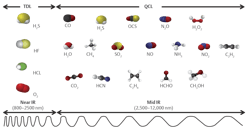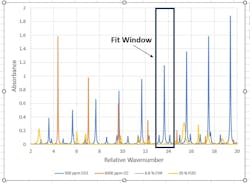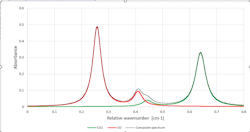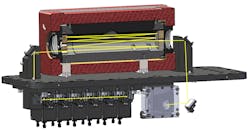New technologies for CEMS monitoring
A continuous emission monitoring system (CEMS) is a requirement for most industrial plants across the globe. Mandated and regulated by the environmental laws of many nations, a CEMS measures and reports airborne emissions of industrial pollutants. Initially the list of mandated measurements was relatively low, but broadening regulations have expanded the number of gases that must be tracked, making the design of a CEMS much more challenging.
This article discusses a new laser-based technology that has become available for CEMS applications. Rather than multiple individual analyzers, each designed for a particular gas, new designs incorporate up to six different lasers, allowing a single analyzer to measure as many as ten gas components simultaneously.
CEMS challenges
With each round of regulation, the requirements for CEMS monitoring have become increasingly stringent. Choosing an appropriate analyzer to measure any given gas component is relatively straightforward, but the addition of new measurements has complicated analyzer selection significantly. Each analyzer technology has specific applications where it performs well, but few technologies can span the broad range of gas component monitoring now required by many CEMS applications.
To comply with regulations, many sites have chosen different analyzer technologies, each measuring a particular gas component. This approach works well initially — but each analyzer has its own maintenance, technical and certification requirements — resulting in complex and costly ongoing maintenance and support. CEMS require high levels of uptime and reliability, exacerbating these issues.
Absorption measurement strategies
Several optical methods are available to measure specific gas components, each shining a light of known frequency through the sample, and then measuring how much light is absorbed by the gas of interest. This measurement can then be used to calculate the concentration of the gas present in the sample.
Nondispersive-infrared (NDIR) analyzers utilize a broadband light source combined with optical filters to measure the absorption of a specific gas in the sample. This technique works well to measure a single gas component quickly and inexpensively, but it cannot monitor multiple gases without employing multiple gas cells, thereby significantly increasing required components.
Fourier-transform infrared (FTIR) is another optical gas analyzer technology. Unlike NDIR, this technology scans across a very wide band of frequencies. It can detect a number of gases in a single sample, but only if the absorption spectrums do not overlap extensively. However, as each scan takes longer than NDIR or laser-based measurement, the use of FTIR in continuous gas measurements is limited.
Laser-based gas analyzers offer another optical detection method by exploiting the advantages of a narrowband laser light source. Utilizing tunable-diode lasers (TDL) and, more recently, quantum cascade lasers (QCL), laser-based analyzers measure a range of frequencies in very targeted sections of the near- and middle-infrared spectrum.
TDL lasers operate in the near-infrared region to measure gases such as H2S, HF, HCL and O2 (Figure 1). QCL lasers cover the mid-infrared region, where high-sensitivity measurement of a broad range of gas components, such as CO, CO2, NO, NO2, SO2, NH3, H2O and many others is now feasible. By using a combination of carefully chosen TDL and QCL lasers, a single analyzer can detect as many as ten different gas components in a gas sample.
Using a narrow-band light emitter such as a laser, where the wavelength can be precisely tailored for the measurement needs, allows optimal configuration to detect the gas of interest. Selection of the appropriate part of a gas’s absorption spectrum, or “fit window,” ensures meeting the application range and limit of detection needs, while simultaneously reducing the presence of cross interfering absorptions from other gases present in the stream (Figure 2).
Unlike NDIR- and FTIR-based methods, an analyzer using laser-based spectroscopic methods produces high resolution data of the target gas absorption. This enables differentiation of each gas by measuring their unique absorption fingerprints, where the gas selectively absorbs light of different frequencies in a region of interest (Figure 3).
Note how the absorption of CO2 (green) and CO (red) overlap near the middle of the graph, but with each having a different peak (CO at 0.25 and CO2 at 0.65) at other points. These unique features, observable when using high-resolution laser-based detection methods, enable the discrimination of contributions from each gas, along with accurate concentration measurements of each, all without cross interference.
TDL- and QCL-based analyzers have inherent advantages over many other technologies. They have no consumable components, reducing life cycle cost, and the solid-state laser’s lack of moving parts extends service life and reduces maintenance. They offer high-accuracy and high-sensitivity measurements without the maintenance requirements and selectivity issues of traditional technologies such as NDIR. Additionally, high-speed, continuous gas analysis is provided, which is not available using other multiple measurement systems, such as FTIR.
TDL/QCL design features
TDL/QCL analyzers incorporate up to six modular lasers in a compact housing, each of which can be directed through a sample cell at a rate greater than 1,000 times a second. Each laser scans a specific range of wavelengths in under one millisecond, measuring absorption levels in targeted windows. The sample cell incorporates multi-pass mirrors (Figure 4), increasing the measurement path through the gas sample, and thereby increasing the analyzer sensitivity, without increasing the analyzer footprint. These analyzers also measure sample pressure and temperature, incorporating these variables in the concentration analysis to provide high-accuracy measurements.
Increased path length, along with focus on a selected range of frequencies, allows a TDL/QCL analyzer to create a much better-defined and higher-resolution absorption spectra (Figure 5) as compared to NDIR and FTIR analyzers. Performance is further enhanced by the very high scan rates, which enable hundreds of measurements a second. Multiple readings allow the analyzer to effectively eliminate spurious noise, and to generate a consistent and reliable reading.
TDL/QCL analyzers have very long service life and low lifecycle costs since they employ very reliable and low-drift, solid-state lasers — and with no consumables required. Best-in-class TDL/QCL analyzers are built with maintenance in mind, incorporating modular-type laser modules, which are easily replaced with no alignment required.
These types of analyzers also have in-built diagnostic features, such as measurement validity checks, along with warning/fault reporting if certain parameters are not within expected tolerances. This information enables timely intervention and ease of trouble shooting to minimize down-time.
There are various analyzer offerings specifically designed for both hot/wet or cold/dry sample systems, allowing the technology to be applied to a very broad range of CEMS applications (Figure 6), and in enclosures for a wide range of plant environments, including hazardous areas.
TDL/QCL case studies
The following upgrade projects applying TDL/QCL CEMS analyzers resulted in significant improvements in performance, with substantial maintenance cost and time reductions.
A major oil producer operating several refineries had to upgrade its CEMS analyzers to meet revised flue gas monitoring requirements. The company’s environmental engineers were able to work with their analyzer vendor to design a set of customized TDL/QCL analyzer cabinets to measure combinations of NO, NO2, CO, SO2, O2, H2O, H2S and CH4. The new analyzer installations report data via the plants’ wireless networks, providing real-time, high-speed analysis. The vendor was able to offer fully fitted analyzer cabinets, providing a complete solution.
A steel mill operator needed a means to monitor NO, NO2 and NH3 with varying ranges of detection in both hot/wet and cold/dry sections of their selective catalytic reduction deNOx process. A combination of higher-tier and lower-cost QCL analyzers were employed, keeping project cost within budget, while meeting reliability and gas sensitivity requirements.
A major refinery wanted to upgrade from traditional analyzer technologies, such as chemiluminescence, to laser-based solutions. The plant employed QCL analyzer systems across a wide range of hot/wet and cold/dry applications in their mercaptan oxidation and sulfur recovery unit process areas. The new installation proved to be far more reliable and accurate, while significantly reducing the maintenance required to keep the analyzers up and running.
Another refinery needed to measure NO, NO2, SO2 (low and high range), CO, O2 and H2O in a single analyzer, while reducing required maintenance. A QCL analyzer was able to meet the challenge, and it has been reliably operating for five years with minimal maintenance.
Conclusion
If a facility’s CEMS system is unable to meet monitoring requirements, and/or if it requires excessive maintenance to provide continuous monitoring, consider an upgrade to a TDL/QCL analyzer. The monitoring requirements of CEMS is a growing and diverse market, and while measurement of components such as dust and mercury require different technologies, TDL/QCL based analyzers offer an optimized solution for measuring the broad array of gases commonly required in CEMS applications.
In fact, a TDL/QCL analyzer can often replace a number of analyzers, and its superior performance, low lifecycle costs and ability to meet a wide range of process applications makes the technology often the best choice for new CEMS installations or analyzer upgrades.
Emerson








